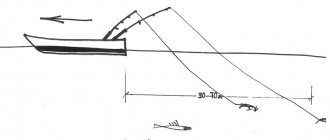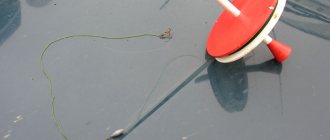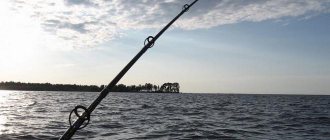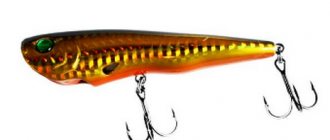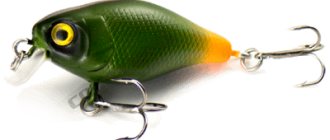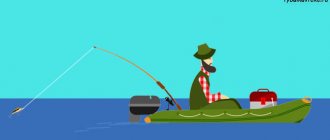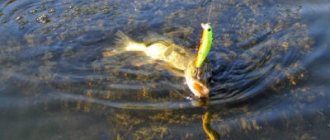The advent of minnow wobblers made a real revolution in spinning fishing.
Minnow wobblers have become the most common class of wobblers among spinning anglers; any angler who is interested in spinning fishing is sure to have them in his arsenal.
Using minnow wobblers you can catch almost any predatory fish that lives in our reservoirs: pike, perch, asp. It is difficult to imagine night fishing for pike perch without these wobblers. Small, light-weight minnow wobblers allow you to catch such conditionally predatory fish as: chub, ide, dace.
The excellent catchability of these wobblers has been proven by their constant use by a large number of professional and advanced spinning anglers.
Nowadays, there are such a huge number of different minnow wobblers on the market that it is extremely difficult for a beginning spinning player to understand all this variety.
Properties of minnow wobblers
The minnow wobbler can be easily distinguished by its appearance from other classes of wobblers:
- Minnows have an oblong, elongated body shape.
- The ratio of the length and height of a minnow wobbler is usually 5:1.
- Minnow wobblers usually have a narrowing in the tail, which makes them look like fry.
- In cross-section, the minnow wobbler most often has a round shape.
- The blade in the front of the minnow wobbler can be of various sizes and shapes, with different
- angle to the wobbler axis.
- Many minnow wobblers are neutrally buoyant, although there are also floating and sinking models.
All these parameters are quite conditional. You can find minnow wobblers that are not round in cross-section, but flattened or, on the contrary, swollen on the sides, but a minnow wobbler is always longer in length than in width and height.
The movements of the minnow wobbler in the water resemble the movements of a fish fry, which explains their name “minnow”, which means “fry”.
In the front part of the minnow wobbler there is a blade, the shape of which determines the nature of the wobbler’s movement in the water.
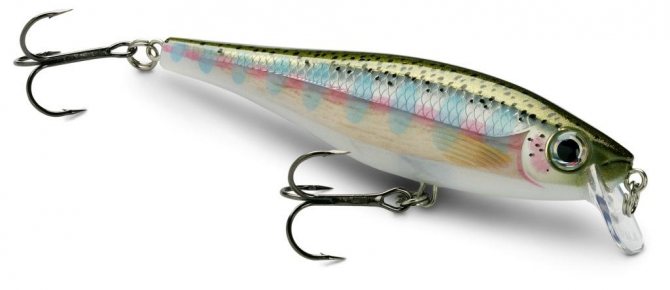
When moving in water, a minnow wobbler can move like a snake or roll from side to side. Although most of these wobblers still have a weakly expressed game of their own. The animation of the wobbler is carried out by the fisherman himself. The main type of wiring for minnow wobblers is jerk wiring, which has given rise to a whole trend in spinning fishing called “twitching.”
Minnow wobblers are usually equipped with two or three tees of a size corresponding to the dimensions of the wobbler itself. There are also composite minnow wobblers.
Many minnow wobblers have a special balancing system built into the body of the bait, which consists of channels and cavities through which steel or tungsten balls move.
The purpose of this balancing system is to increase the casting range of the wobbler, as well as to ensure stability of the wobbler during play and jerking.
Wobblers without blade
Wobblers without a blade are less effective, since due to its absence, they practically do not play in the water. The success of fishing depends entirely on the skill of the fisherman and the correct fishing technique. Lures without a blade come in medium depth and work on the surface.
Medium depth wobblers

Wobblers without a blade usually do not dive deeper than 1-2 meters. The most common types working at medium depths are jerkbaits, rattlins and darters:
- A rattlin is a wobbler that has balls inside its body that create noise when moving. This is what attracts predators. The fishing line is attached not in the bow, but on the back of the bait. The rattlin's shape is usually flat. All these qualities combine to create an interesting game of sound effects;
- A darter is a bait that looks like a minnow (only without a blade). The bow has an inclined cut, which ensures low-frequency play of the wobbler. Darters are in great demand in sea fishing. They are designed for long casts, since, thanks to their special shape, the weight is transferred to the tail in the process.
Surface wobblers without blade
Wobblers that do not dive more than a meter and float along the surface of the water are surface baits.
This type includes:
How to catch more fish?
I have been active fishing for quite some time and have found many ways to improve the bite. And here are the most effective:
- Bite activator. Attracts fish in cold and warm water with the help of pheromones included in the composition and stimulates its appetite. It’s a pity that Rosprirodnadzor wants to impose a ban on its sale.
- More sensitive gear. Reviews and instructions for other types of gear can be found on the pages of my website.
- Lures using pheromones.
You can get the rest of the secrets of successful fishing for free by reading our other articles on the site.
- Poppers are wobblers that have a bowl-shaped recess in the nose. When jerked, it makes a gurgling sound and attracts predators. This bait works on any large fish. According to the observations of professionals, upon hearing a gurgling sound, a pike can rise from a depth of 1-5 meters.
- wobblers are baits whose game consists of the wobbler darting from side to side. However, he does not have his own game during a calm drive.
Degree of buoyancy
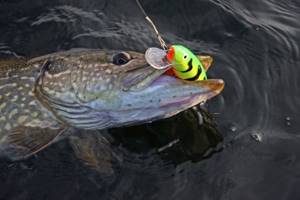
Minnow wobblers are divided into three groups according to the degree of buoyancy: floating, sinking and suspenders (wobblers with neutral buoyancy).
Typically, special letters appearing in the marking of a wobbler indicate the degree of its buoyancy:
- F – floating, floating wobblers
- SP – suspending, wobblers with neutral buoyancy
- S – sinking, sinking wobblers
Most minnow wobblers are often produced in the form of suspenders. Minnows with neutral buoyancy (suspenders) are designated by the index “SP” in the wobbler marking.
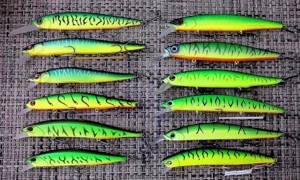
Minnow suspenders have several serious advantages:
- A suspended wobbler can hang in the water column, which floating and sinking wobblers cannot do.
- The suspender is capable of provoking the fish to attack during a pause. The jerks produced by the fisherman during jerking retrieves attract the attention of a predator at a great distance. After the jerk there is a pause, this is what gives the predator the opportunity to attack the bait. In addition, during a pause, the wobbler makes small damped oscillations, which additionally provoke the fish to attack the bait.
- A suspended minnow often has more weight than a floating wobbler, and therefore has better flight characteristics. A minnow with neutral buoyancy gives the angler maximum opportunity to use different types of retrieves and bait animation techniques.
You may be interested in: Sudak
When fishing with a suspender, the angler needs to be careful when choosing metal leads and other equipment elements. If the weight is incorrectly selected, they can turn a wobbler with neutral buoyancy into a sinking one.
Another group of minnow wobblers are sinking minnows, designated “S” - Sinking. Most often, sinking minnows are used in strong currents, when you need to drive the wobbler to a certain fishing horizon and keep it there, while maintaining proper play.
Sinking minnows have a decent weight, so they have the best flight characteristics among all minnow wobblers.
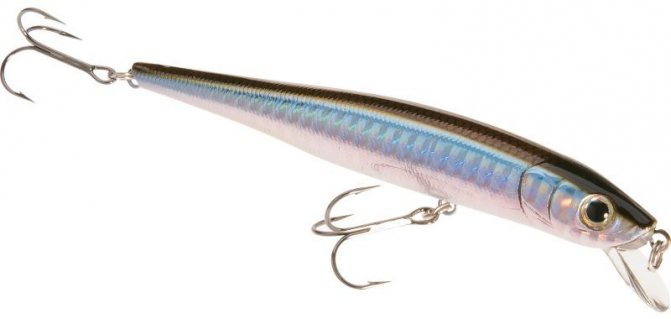
Sinking minnows are usually used with high-speed retrieves. It is very convenient to use sinking minnows when exploring large areas of an unfamiliar body of water. The wobbler is cast over a long distance, driven in a high-speed style, the active predator rushes after the bait running away from it.
The last group of minnow wobblers in terms of buoyancy are floating minnows, they are designated “F” - Floating. When retrieving, a floating minnow is buried to a certain depth, and when the reeling is stopped, it floats up, and the speed of ascent can be different, there are minnows that float up quickly, there are those that float up extremely slowly.

Floating minnows have several advantages:
- Floating minnows can be guided with a “stop&go” wiring; such wiring allows you to pass obstacles at the bottom and is good at tempting a passive predator to attack.
- Floating minnows can be caught in areas of reservoirs overgrown with dense bottom vegetation
- Floating minnows often have their own game, which allows them to be guided, including by regular even wiring.
It is advisable for an angler to have in his arsenal a minnow wobbler with different degrees of buoyancy, this gives the angler the opportunity to use different types of retrieves for different fishing conditions.
Deepening minnow wobblers

Based on the depth at which the wobbler operates, minnows are divided into several groups:
- SSR - Super Shallow Runner, ultra-shallow wobblers, working depth of several centimeters or work along the very surface. As a rule, minnow wobblers of this group have positive buoyancy and are designed for fishing in heavily overgrown areas of reservoirs, when there are literally a few centimeters left from the surface of the water to the grass, in which the wobbler is inserted.
- SR - Shallow Runner, shallow wobblers, working depth 0.3-0.5 meters. According to the degree of buoyancy, they can be either floating, sinking or suspending. SR class minnows are effective for fishing shallow areas of reservoirs, coastal areas and shallows, especially in summer, where the bulk of the fry is concentrated at this time of year, and where the fry is, there is a predator.
- MR - Medium Runner, medium depth, working depth up to 1.5 meters. Wobblers with such depth catch pike and pike perch well. Pike are caught well when moving a wobbler along the grass, as close to the vegetation as possible. Recently, many fishermen have been using large wobblers, up to 130 mm long, for pike fishing. A large wobbler creates strong turbulences of water around itself and gives a strong acoustic signal, which attract a large predator and provoke it to attack. Such wobblers also give good results in large bodies of water, when guiding along a riverbed or bank edge; the catch here can be both pike and pike perch.
- DR - Deep Runner, wobblers with a high degree of penetration, working depth 1.5-2.5 meters. Deep-sea minnows allow you to fish channel edges and local holes in large and deep reservoirs. Due to their working depth, deep-sea minnows in these conditions make it possible to qualitatively fish such places and can give a very good catch.
- DD - Deep Diving, baits that go as deep as possible, working depth is more than 2.5 meters. They can be very effective when fishing for pike and pike perch at great depths.
You may be interested in: Spoons
Manufacturers of minnow wobblers indicate the working depth of the wobbler in meters or feet, as well as the degree of buoyancy of the wobbler. The fisherman should pay close attention to these parameters when choosing bait in the store.
In conclusion, it should be added that the most popular wobblers among spinning anglers are minnows, which have a working horizon of 0.5 to 1.5 meters. This degree of depth is quite enough to fish most promising places, and such baits are the basis of the arsenal of an angler who fishes with minnow wobblers.
Wobbler minnow Deps Balisong Minnow 100 SP
One of the deepest minnow wobblers in this class, considering that this is not a deep bait, a depth of 1.5–2 m is not a problem for it. Moreover, even at depth, its ability to appetizingly shake its sides after a jerk remains. One of the classic options for fishing at a depth of 2–3 m. This minnow wobbler Deps Balisong Minnow 100 SP is partly similar in shape to the X-Rap, however, despite the overall size of 100 mm, it looks much larger and more overall. Which cannot but affect behavior in water. The movements of the minnow wobbler Deps Balisong Minnow 100 SP are less nimble, but wider and sharper, with additional trembling, which is always to the liking of the pike. Among other things, the wobbler has a good acoustic effect due to the balls inside the body. In terms of animation, there is a huge field for experimentation here, so I won’t even highlight any best wiring for this wobbler. Everything will depend on your imagination; the minnow wobbler Deps Balisong Minnow 100 SP will cope with any option offered to it.
Size
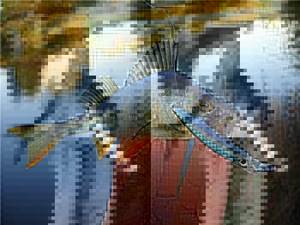
The sizes of minnow wobblers are comparable to the sizes of other types of wobblers. Based on size, minnows can be divided into four groups:
- Minnow ultralight class - wobbler weight up to 5 grams, length up to 5 cm. Minnows of this size are used for catching chub, ide, perch.
- Minnow light class - wobbler weight up to 8 grams, length up to 7–8 cm. Used for catching large perch and small pike.
- Medium-sized minnow - wobbler weight up to 12–14 grams, length up to 12 cm. The most common size for minnow wobblers; with a wobbler of this size you can catch pike, asp, and pike perch.
- Heavy class minnow - wobbler weight over 12 grams, length from 12 cm or more. Used for catching trophy size pike. Recently they have become more and more popular.
Minnow color
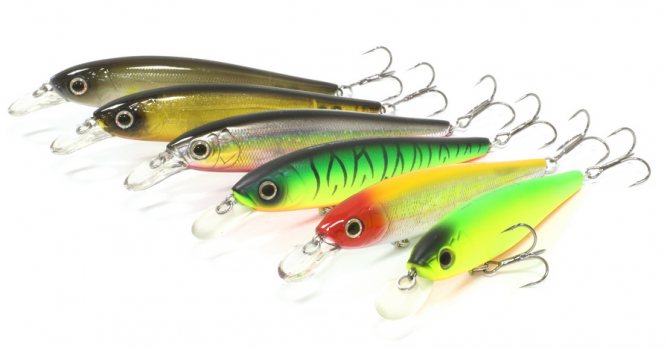
The color of the minnow wobbler plays a lesser role than the correct selection of bait for the fishing conditions and the correct retrieve.
But sometimes the color of a minnow can also play a role in the success of fishing, because often a minnow, especially a suspender, hovering for a pause in the water column, gives the pike time to see itself.

Many fishermen adhere to this tactic when choosing the color of a minnow. In an unfamiliar place, first try minnow wobblers of natural colors; if there is no interest in them on the part of the predator, you can try to catch minnows of provocative colors.
Minnow wobblers with bright, provocative colors have another plus: they are clearly visible from afar, which makes it possible to both control the wiring and avoid obstacles in time.
Among the provocative colors of the minnow, the color of Mat Tiger should be especially noted; this poisonous yellow-green color of the wobbler, although it has no analogues in nature, shows itself very well when catching pike in both deep and shallow water.
Wobbler minnow Zip Baits Orbit 110 SP
A very nice addition to the Orbit lineup from a serious Japanese company producing plastic baits. This “caries remedy for pike teeth” in sizes 65 and 80 mm has long found fame and respect among spinning fans. The older brother is just as good-looking as his smaller relatives. Traditionally, the minnow Zip Baits Orbit 110 SP wobbler has a protruding body with a rounded cross-section, which allows for stable and clear play when twitching. Thanks to the magnetic system found in most Zip Baits wobblers, including this wobbler, it takes a leading position in terms of range, which is always to the advantage of the spinner. Especially when fishing for pike in large water areas. The working horizon is 0.8–1 m and the floating degree of buoyancy makes it possible to fish at the main depths of pike sites in the summer. The best option for animation is, naturally, twitching in all its forms. The minnow Zip Baits Orbit 110 SP wobbler has the positive feature of instantly responding to any movements of the spinning rod due to better gliding in the water. And even with the slightest twitching, the wobbler will go nose down. This is also facilitated by a slight shift of the center of gravity to the head part due to the brass weight installed there. And this feature, after the next jerk, going nose down, like a feeding fry, is very popular among pike.
Minnow wobbler blade

The shape and size of the blade of a minnow wobbler has a decisive influence on the game and behavior of the wobbler in the water. When choosing a wobbler, be sure to pay close attention to the following parameters:
- Blade width - the amplitude of wobbler vibrations depends on the width of the blade. A wide blade causes the wobbler to move more strongly to the left and right. A narrower blade causes the wobbler to tremble more rather than toss from side to side.
- Blade length - the depth of immersion of the wobbler depends on the length of the blade. The longer the blade, the deeper the wobbler will go when retrieving.
- Blade inclination - the angle of inclination of the blade determines the speed at which the wobbler will go deeper. The smaller the angle of inclination, the deeper and faster it will sink into the depths.
The blade of a wobbler is of such great importance that two absolutely identical wobblers, differing only in the shape of the blade, will behave on the retrieve like two completely different wobblers.
Minnow wobblers of the classic minnow shape have a weakly defined game of their own, but there are minnow wobblers with a taller body that have their own game; they perform well on even retrieves, and especially on “stop and go” retrieves. Consider this factor when choosing a minnow wobbler for fishing.
You may be interested in: New for 2021 - Shimano Stella FJ Reel
Wobbler minnow Pontoon 21 Moby Dick 100 F SR
The Pontoon 21 company continues to delight spinning anglers with more and more new models of wobblers for a wide variety of fishing conditions. And, of course, it would be strange if the company’s product range did not include a large minnow pike wobbler. This minnow Pontoon 21 Moby Dick 100 F SR wobbler is available in two sizes (100 and 120 mm) and three depth options (DR, MR, SR). Of course, the older Moby Dick wobbler deserves attention, but with its dimensions and weight of 30 grams, it is more likely to be considered a macrominnow. Therefore, in this context, we will consider a floating version in size 100 mm with a depth of 0.3 to 0.5 m.
Thanks to the unique geometry of the body, the minnow Pontoon 21 Moby Dick 100 F SR wobbler does not have the highest frequency, but it has a very amplitude game, which pikes always like. This allows it to work well both on uniform wiring and twitching. Using the Mag Force magnetic balancing system, a very decent flight range is achieved. Which is an integral characteristic of shallow-water wobblers, which most often have to work across areas. In such conditions, when there is no reference to a specific fishing location, but the background depth is about a meter, the easiest way is to drive the minnow Pontoon 21 Moby Dick 100 F SR wobbler using stop and go wiring or simply evenly with minimal acceleration and twitching. When driving it with a uniform retrieve, it is best not to accelerate too much, but to keep the pace so that you can just feel the play of the wobbler. And it will be very useful to periodically make one or two jerks, after which give a short pause.
Tackle for fishing with minnow
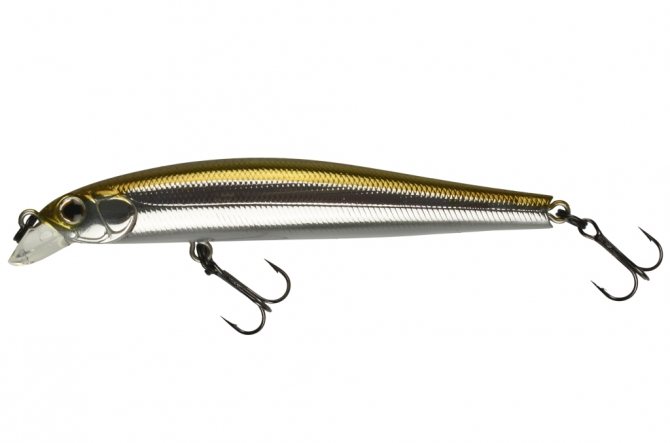
Minnow wobblers require a suitable spinning kit, for this it must meet certain criteria:
- The optimal rod length is 2.10 meters.
- The action of the rod should be fast; if you have some experience, you can fish with a fairly soft rod, but still a rigid rod with a fast action is preferable.
- The test rod must match the bait used, or even be slightly larger than the weight of the bait used, to ensure the necessary power reserve.
- The handle of the rod should be short enough to make it convenient for jerking.
- The reel must be well balanced with the rod and have a high-quality drag.
- To catch pike, the use of a metal leash is mandatory.
- Braided fishing line is a must, only it can provide a good connection with the bait and only with it can the correct animation of the bait be performed.
Wiring minnow wobblers
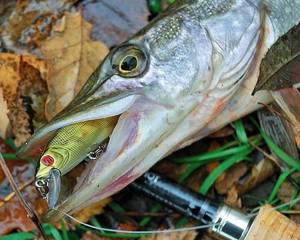
Minnow wobblers are inseparable from jerk wiring. Thanks to minnow wobblers, a whole direction in spinning fishing called twitching arose.
Twitching came to us from American spinning anglers; it involves uneven retrieving of the bait, performed with various stops, pulls, twitches and other methods of bait animation.
Most minnow wobblers do not have their own game; on a uniform retrieve, they behave too sluggish and uninteresting for a predator. It is twitching that makes the bait resemble a wounded, fleeing fish, capable of provoking even a well-fed and passive predator to attack.
Each manufacturer of a minnow wobbler puts a certain idea and purpose into its design, the goal of the spinner is to understand this idea embedded in the wobbler and, by selecting the optimal wiring, to reveal the potential inherent in this wobbler. And then the minnow begins to fish.
There are two types of animation of minnow wobblers:
- Rhythmic - wiring consists of a series of repeated jerks and pauses.
- Chaotic is a more complex method of animation, consisting of a haphazard change of jerks, stretches and long and short pauses.
There are two basic types of wobbler movement in twitching:
- Jerk is a sharp and energetic movement of a wobbler in water.
- Pulling is a smoother and slower movement of the wobbler; when pulling, the angler seems to be dragging the bait through the water column.
Spinningists distinguish two types of twitching:
- Soft twitching - the spinning player makes smooth pulls and smooth jerks with the wobbler, the wobbler seems to glide smoothly in the water column. This type of twitching is used for passive fish.
- Hard twitching - the spinner makes sharp jerks, during which the wobbler moves very quickly, deviates strongly and sharply to the side. Suitable for active fish.
It is advisable to change the wiring pattern of the minnow wobbler. It often happens that a predator follows the bait, but does not dare to attack it, and suddenly a sharp change in the behavior of the bait provokes it to grab it.
A spinner can try the following experiments while fishing:
- Alternate measured stretches with pauses and sharp jerks
- After a series of jerks, make a sharp and long pull with the rod
- Pause longer and move the wobbler slightly
Different minnow wobblers require different wiring; choosing the right wiring for the wobbler is the main task of a spinner fishing with a minnow. Understanding correct wiring comes with experience.

